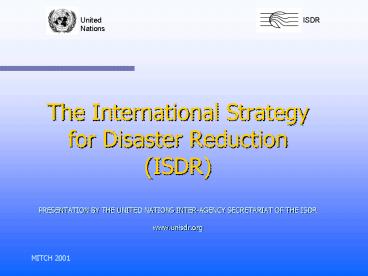The International Strategy for Disaster Reduction ISDR PRESENTATION BY THE UNITED NATIONS INTERAGENC - PowerPoint PPT Presentation
1 / 21
Title:
The International Strategy for Disaster Reduction ISDR PRESENTATION BY THE UNITED NATIONS INTERAGENC
Description:
MITCH 2001. The International Strategy for Disaster Reduction (ISDR) ... Kofi Annan, 'Facing the Humanitarian Challenge: Towards a Culture of Prevention', UNGA, A/54/1 ... – PowerPoint PPT presentation
Number of Views:693
Avg rating:3.0/5.0
Title: The International Strategy for Disaster Reduction ISDR PRESENTATION BY THE UNITED NATIONS INTERAGENC
1
The International Strategy for Disaster Reduction
(ISDR)PRESENTATION BY THE UNITED NATIONS
INTER-AGENCY SECRETARIAT OF THE
ISDRwww.unisdr.org
ISDR
United
Nations
2
(No Transcript)
3
Some areas are projected to become wetter,
others drier (IPCC)
4
The frequency, persistence and magnitude of
El-Niño events has increased (IPCC)
5
Effects of a Changing Climate on Frequency of
Extreme Events (WMO/WCP)
6
Global Trends
EXTREME EVENTS
Climate change and variables
VULNERABILITY
Poverty Environment degradation Population
(mainly urban) growth Health issues
7
Definition of Core Concepts
Disaster Reduction involves measures designed to
avoid (prevention) or limit (mitigation and
preparedness) the adverse impact of natural
hazards and related environmental and
technological disasters Disaster Prevention
involves the outright avoidance of the adverse
impact of natural hazards and related
environmental and technological
disasters Disaster Mitigation involves measures
taken to limit the adverse impact of natural
hazards and related environmental and
technological disasters Disaster Preparedness
involves measures taken in advance to ensure
effective response to the impact of disasters
8
LESSONS OF THE DECADE (IDNDR 1990-1999)
1. New, multiple forms of hazards compound
effects of natural, environmental, technological
hazards 2. Shift from an emphasis on hazards to
an emphasis on vulnerability and to social and
economic factors
9
LESSONS OF THE DECADE (IDNDR 1990-1999)
3. Shift from emergency response to
prevention 4. More numerous and broader range
of entities involved in risk reduction.
10
- Incorporate risk reduction measures into
sustainable development - Link with Agenda 21 and environmental concerns
(upcoming Summit for Sustainable development) - Link with climate change agenda
- Link with poverty eradication strategies
- Link with water management strategies - drought
and floods - Link with Habitat and human settlements Agenda
11
How is ISDR implemented?
- Inter-Agency Task Force
- Inter-Agency Secretariat
- National Committees
- Partner Networks and Regional Centres
12
Inter-Agency Task Force
- UN agencies FAO, UNESCO, ITU, WMO, UNDP, UNEP,
WFP, World Bank - Regional entities Council of Europe, ADPC, OAU,
OAS/IACNDR, SOPAC - Civil society and NGOs IUCN, IFRC, ICSU, Munich
RE, ICDO, DMC, Disaster Prevention Bureau, Japan,
National Direction of Meteorology, Uruguay
13
Framework for Action
- Stimulating interdisciplinary and inter-sectoral
partnership at all levels - Increasing public awareness
- Obtaining commitment from public authorities
- Improving further the scientific knowledge of the
causes of natural disasters and the effects of
hazards, as well as its application to increase
disaster resilience
14
Additional Mandated Tasks
- Early Warning Programme
- Support to all countries to ensure ready access
to global, regional national and local warning
systems, as part of their national development
plans. - Climate and Disasters
- International Cooperation to Reduce the Impact of
the El Niño Phenomenon
15
Applying Hydrometeorological Information to Risk
Reduction (continued)
medium to short term contingency planning
information to authorities/ media/public
assemble emergency teams storage of resources
1. FORECAST AND PROVISION OF WARNINGS
Contributes to preparedness
16
Applying Hydrometeorological Information to Risk
Reduction
assessment of risk land-use planning
design of infrastructures scenario building
awareness raising
2. KNOWLEDGE
Contributes to the broad reduction of risk
17
Natural legacy Extreme climatic variability (/-
35), recurrent floods and droughts (World Bank)
n
18
Volatility in Sectoral Output parallels
Fluctuation in precipitation (World Bank)
n
19
Rainfall Variability affects growth (World Bank)
20
Scientific Technical Analysis Prediction
Social Economic Actions
Global Analysis Prediction Centres
International User Organizations
Global Synthesis
Regional User Organizations
Regional Climate Centres
Regional Synthesis
National Climate Centres
National/ Local Synthesis
National Local Users
Climate information flow
21
thank you
History tells us that single-cause explanations
of natural disasters are invariably too
simplistic. This means that no simple,
all-embracing solution is possible either. To
address complex causes we need complex,
inter-disciplinary solutions. The fundamental
point is that implementing prevention strategies
requires cooperation across a broad range of
different agencies and departments.
Kofi Annan, Facing the Humanitarian Challenge
Towards a Culture of Prevention, UNGA, A/54/1

